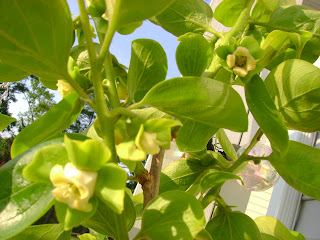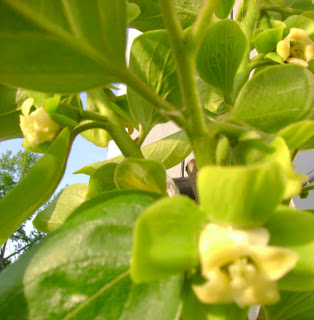
This new Fuyu persimmon tree had already blossomed when I bought it. It is a replacement for the dead Nectarine tree (see here). The reason I pick another persimmon tree is because Persimmon can adapt to a wide range of soils and climates, and it's immune from most disease and insects (at least less maintenance than Nectarine tree). The leaves are glossy and leathery and may be yellow or reddish-purple in the fall. Persimmon flowers look like bell-shaped with creamy to greenish-yellow, fragrant, usually with 4 thick, recurved lobes and staminate flowers in 2-3-flowered clusters. It flowers in March-June and fruits in September-November. Small fruit is greenish to yellowish with highly astringent pulp before ripening, turning yellowish-orange to reddish-orange and sweet in the fall.
The Fuyu species are almost seedless. The wood of persimmon is hard, smooth, and even textured. Asian remedy uses unripe fruit and inner bark has been used in the treatment of fever, diarrhea, and hemorrhage. The fruits are used in puddings, cookies, cakes, custard, and sherbet; the dried, roasted, ground seeds have been used as a substitute for coffee.
Persimmon tree can tolerate hot, dry, poor soils, including various city conditions, but moist and well-drained soils provide best conditions. The most important is plant it in well-drained soil, one of my trees die due to poor drainage.
It is a long life tree; some trees have been reported to reach 150 years of age. Good fruit crops are borne every 2 years. Persimmon is slow growing and tree is usually not very large size. The tree sends down a deep taproot, which makes it a good species for erosion control but makes it difficult to transplant.
Most of the fruit trees will encounter some types of disease. So, watch out for the webworm and hickory horned devil that caused the diseases on persimmon tree. An infected tree lives 1-2 years after the wilting appears. Small branches severed by a twig girdler are often encountered; the wounds allow entry of a wilt fungus Cephalosporium Diospyri that can kill the persimmon tree. Like most of the fruit trees, persimmon tree also attract animals. Leaves and twigs of common persimmon are eaten in fall and winter by white-tailed deer. The fruit is eaten by various birds, deer, and other wild life.




 Need to dig a bigger hole
Need to dig a bigger hole Miracle-Gro® soil - with bad smell
Miracle-Gro® soil - with bad smell



Interesting readings:
http://www.seedtosupper.com/persimmons.html
Persimmon Fruits Fact
http://www.crfg.org/pubs/ff/persimmon.html
WHY FRUIT TREES ARE GRAFTED?
http://www.midfex.org/m/whygraft.html






.jpg)







































































The lemon green leaves are so nice making the tree look good. Wow this tree can reach 150 years old? That's about two generations. Your children or even your grandchildren will get to taste the benefits of this tree also :-) Btw, about soil, the better the soil is, the more smelly it is he he :-(
ReplyDelete